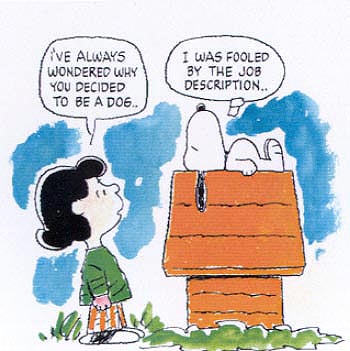I hear a death knell in the distance, it isn’t fully audible
but I know it is coming nonetheless. The traditional job description is gasping
its last imperfect breaths, slipping down into obscurity with “ineffective”
stamped clearly on the headstone ... well, in my mind anyway!
I have always hated job descriptions. This is perhaps partly
because I had to re-write each and every one multiple times at a previous job.
Having said that the fact that we actually dug them out of the filing cabinet was
a miracle in itself.
 How many times have
you changed roles or been somewhere for a while and realised that you either
don’t have a job description or it doesn’t even remotely resemble what you do?
How many times have
you changed roles or been somewhere for a while and realised that you either
don’t have a job description or it doesn’t even remotely resemble what you do?
I can’t remember a time when the daily tasks of my role have
fitted the description I was given when applying for a job ... and this isn’t necessarily
a bad thing. In fact, I am convinced that it is often the things that you do in
work that aren’t listed out on a piece of paper that are the most interesting,
engaging and enthralling. But that isn’t the issue.
The problem with job descriptions is that they set a rigid
list of tasks for something that is undoubtedly going to be fluid. Jobs are
multi-dimensional and setting someone in a box either leads to your brightest
and most talented employees becoming bored and deserting you or it leads to the
job description becoming obsolete and meaningless.
Job descriptions tend to be written with potential
applicants in mind. The classic look of horror on an HR personnel’s face when
they realise that they are due to advertise a new job opening but the job
description is out of date or non-existent. No matter how urgent the job
search, nothing will move forward until the job description has been produced
and signed off (probably by someone important)!
Writing with a job applicant in mind leads to pages and
pages of gumpf that is meant to make the job appear more attractive by
including absolutely every task someone might possibly do in a role ...
obviously aiming to cast the nets wide in the hope of a good catch rather than
being more targeted.
One of my job descriptions, as I came to find after I had
started the job, had actually listed the tasks and skills that you would need
if you were going to work in every position in the department. I almost didn’t
apply because I was nervous that I didn’t have enough experience to work in the
role effectively. As it was I was absolutely fine but I ended up doing a number
of things that weren’t even on the list anyway (and not doing many of the tasks
that were!) ... but it just goes to show that job descriptions can often become
deterrents to potential new blood.
OK, so job descriptions are outdated and inflexible. Let’s
get rid of them! Ah, but there appears to be a few issues with casting them out
forever:
- How would we let potential applicants know what a role entails?
- Where would we anchor performance metrics to?
- How would we iron out the uncertainty of who does what?
These are but a few of the issues with cutting off the age
old job description forever. So perhaps rather than axing it all together we
need to think of ways that we can be more flexible and move the dusty and
rusting job description forward with the times. Making changes to job
descriptions always throws up questions around compliance with employment law but
in my mind out of date or obsolete descriptions do the same thing so we shouldn’t
hold back!
I have listed below a few potential changes that have sprung
to mind but I definitely want to re-visit this topic later on down the line
(after hearing your ideas too!).
- Have a core description for a role but leave room for specialisms, specific and developmental projects – everyone will be doing something slightly different
- Rather than talking about tasks, talk about skill sets – this way the job description will be more adaptable and won’t scare off potential employees
- Tie performance management expectations with the job description but make sure it is up-to-date and current
- Don’t just rely on HR to do it all – take ownership, after all it is you that knows what the job entails
- Don’t be afraid to make changes!
The reality is that organisations need to be flexible and
have room to manoeuvre. This is going to be virtually impossible if jobs are inadaptable.
If they are flexible and easy to change to suit business needs you are one step
in the right direction but this doesn’t mean that companies can sit back whilst
job descriptions languish or remain stretches away from the reality. Keeping
job descriptions fresh and alive is not just a role for our HR departments but
the responsibility of the organisation AND its employees. We must find a way of
being more flexible and adaptable whilst having a clear idea of our
responsibilities and how, as an employee, we will be measured.
To me, the traditional job description is defunct. I know
that something more flexible and interactive is needed but I am not 100% sure
what that is yet – what do you think?